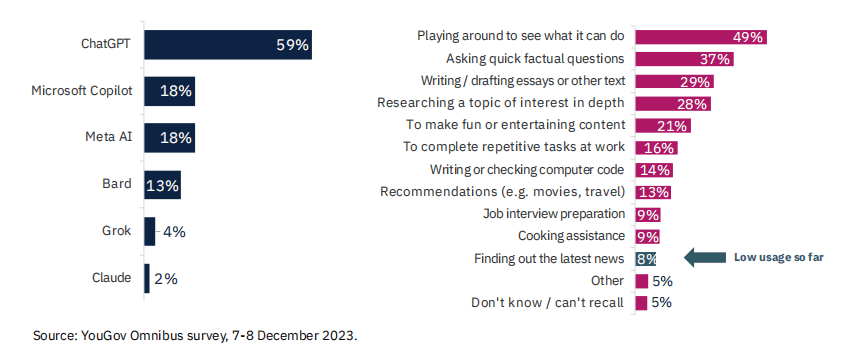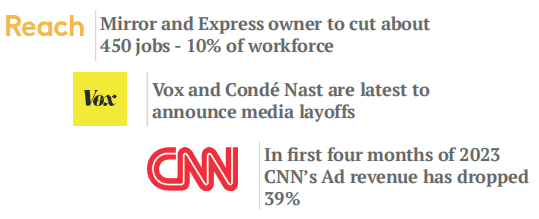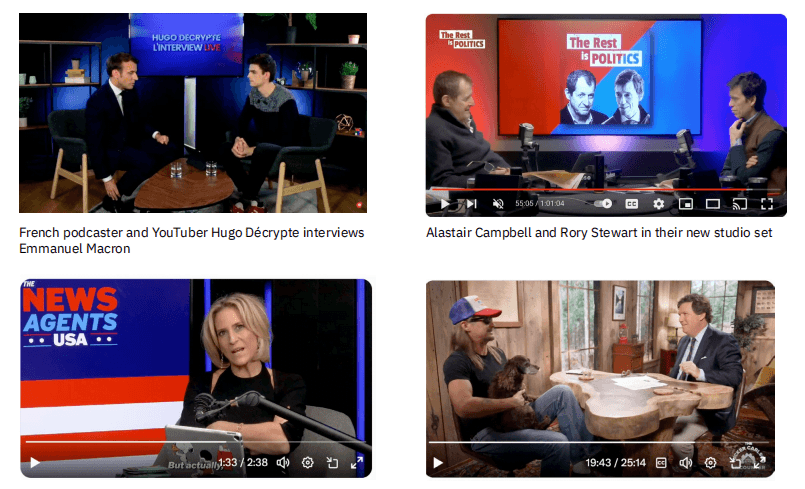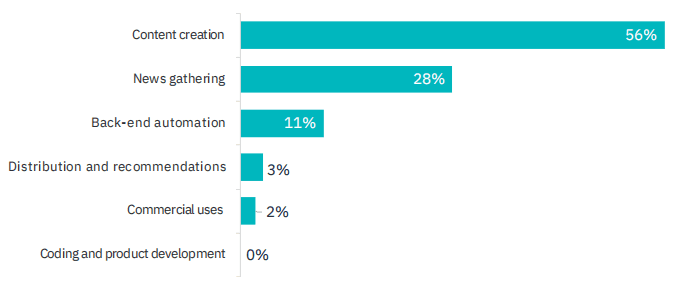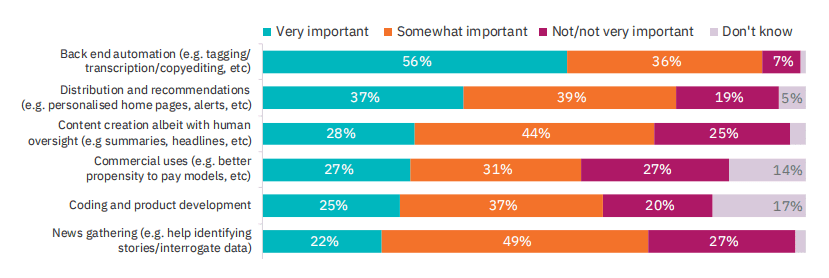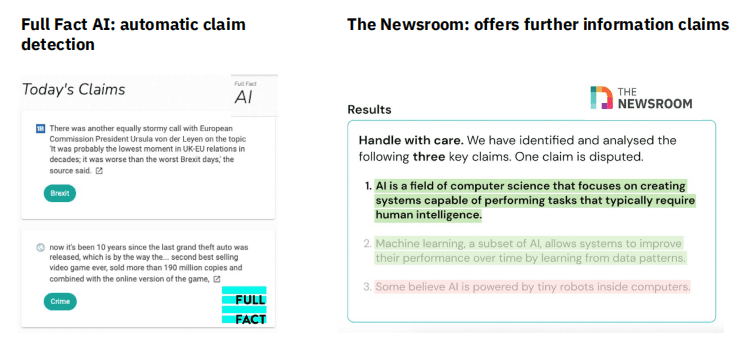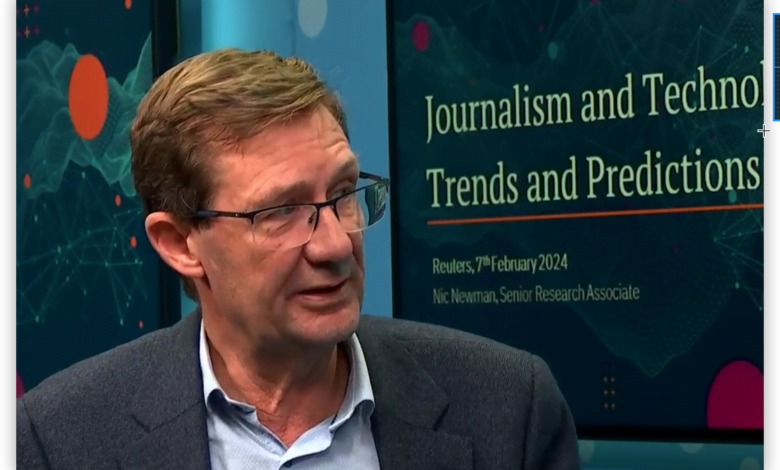
The Reuters Institute for the Study of Journalism has released its latest report on “Journalism, Media, and Technology Trends and Predictions for 2024“, by Nic Newman. The report, supported by the Google News Initiative, provides insights into the changing landscape of journalism and media, with a focus on the impact of technology and shifting consumer preferences.
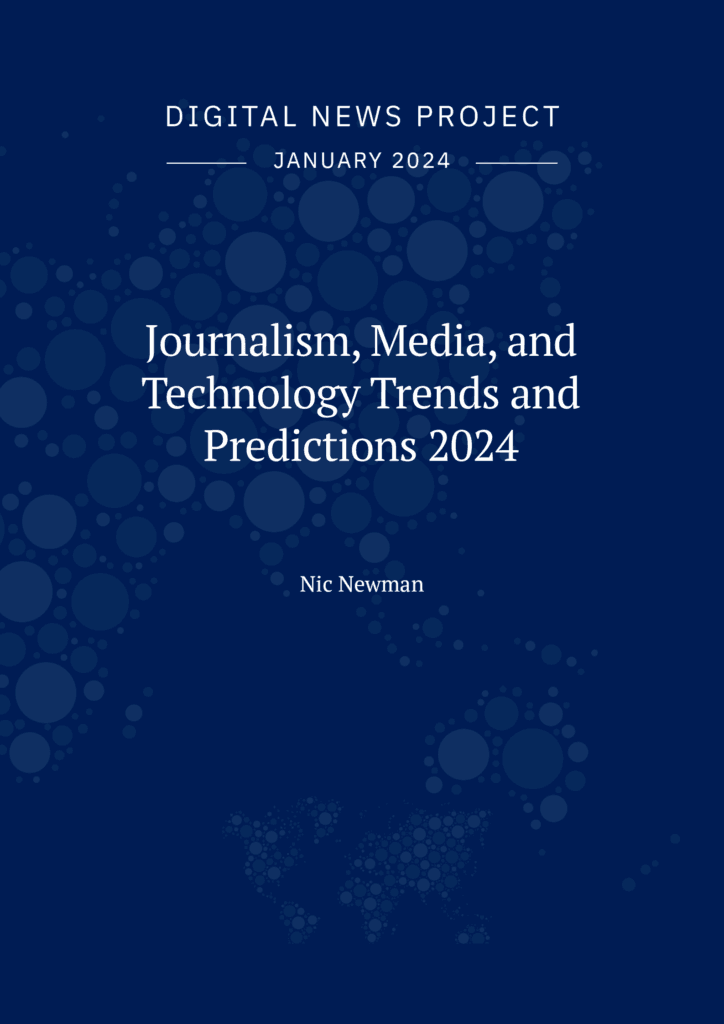
The report includes a survey of worldwide senior digital leaders, and covers topics such as the future of search, the business of journalism, and changing formats of news. It warns that the meteoric rise of AI will send shockwaves through the media landscape this year. With generative AI gaining the ability to create convincing content and directly answer queries, it threatens to undermine the core functions and business models of journalism. This comes amid a backdrop of major geopolitical events, economic turmoil, and weakening public trust that is already straining newsrooms worldwide.
Section 1: A Challenging Road Ahead
In the first section, the report captures the mix of apprehension and cautious optimism within the industry. Only 47% of publishers and editors surveyed felt confident about the year ahead, citing revenue declines, rising costs, and heightened legal/physical risks to journalists. However, some see high-stakes elections as potential audience boosters, even as they worry about further erosion of trust due to political polarization.

Section 2: Social Media’s Disruption Escalates
This section shines a light on the dramatic pivot away from legacy social platforms like Facebook and Twitter by news publishers. Referral traffic from these sites plummeted by around 50% and 27% respectively in 2023 as they de-prioritized news content. In reaction, 77% of publishers say they will double down on owned channels like websites and newsletters in 2024, with some also cutting costs or exploring alternative distribution via WhatsApp, TikTok and YouTube.
Section 3: Search Undergoes an AI Makeover
Arguably the biggest disruption examined is the integration of generative AI into internet search. Companies like Microsoft and Google are now rolling out capabilities that generate direct answers to queries without sending users to websites. Publishers fear this could terminate the flow of traffic to their sites. The report predicts an escalating legal battle as publishers sue AI companies for fair compensation over using copyrighted content to train their large language models.
Section 4: Subscriptions Can’t Offset Ad Declines
On the business side, the report depicts a media industry being battered by a contracting advertising market and fragmenting audiences. It highlights the wave of job cuts and newspaper closures in 2023, even as subscription models provided a revenue lifeline for some publishers. However, with digital subscription growth slowing, the report expects 2024 to bring innovations like all-access content bundles, cheaper access extensions, and differential pricing to retain price-sensitive subscribers.
Section 5: More Audio and Video Formats Coming
The report highlights how the traditional text article is being complemented by more video and audio formats as publishers adapt to changing consumption patterns, especially among younger audiences. Most surveyed publishers plan to produce more video (64% net score), podcasts (52%), and newsletters (47%) in 2024, even as text articles remain critical.
Some key audio/video trends expected:
- More vertical video for platforms like TikTok and YouTube Shorts to attract Gen Z
- Visual distribution of popular political/interview podcasts on YouTube
- Paid podcast subscriptions like The Economist’s recent audio paywall
- “Unbundled” paid newsletters from major brands like the Financial Times
Section 6: Battling News Fatigue and Selective Avoidance
Newsrooms are grappling with the challenge of news avoidance, with 54% of surveyed publishers admitting to prioritizing maximum audience attention over being respectful of people’s time. However, most see value in solutions like better explaining complex issues (67%), solutions-oriented journalism (44%), and inspirational human stories (43%) to re-engage disconnected audiences.
Other noteworthy trends:
- Using AI to reformat news in simpler language tailored for specific groups
- More constructive climate coverage focused on solutions over doomsday narratives
- Amplifying diverse voices and perspectives from local communities
Section 7: Integrating Generative AI into Newsrooms
AI-driven automation of routine tasks like transcription, copyediting, and metadata tagging is a top priority for 56% of publishers surveyed. However, there are significant concerns around the risks of AI for content creation (56% see major reputational risk). Early AI use cases highlighted include:
- Automated article/content summaries and image illustrations
- AI presenters/newscasters like Slovakia’s “Hacsiko” DJ and experimental AI TV channels
- Establishing senior AI leadership roles and cross-industry ethics guidelines
Major publishers are also forming dedicated AI teams to explore integration possibilities while emphasizing human editorial expertise. For example, The New York Times has launched an AI newsroom team to experiment with ways AI can augment journalism, while underscoring that human judgment and reporting will remain core to their mission.
While divisions remain on the extent of AI integration, the report predicts this will be the year generative AI becomes deeply embedded across editorial workflows and tools like Helsingin Sanomat’s “Hennibot” assistant become commonplace.
Section 8: “Artificial Intelligence, Elections, and the News”
The upcoming elections in over 40 countries in 2024 have raised concerns about how AI technologies might be misused by politicians, activists, and bad actors to influence results. There were already instances in recent elections in Argentina and Slovakia where AI-generated imagery and audio were used to spread disinformation and denigrate candidates.
While these interventions haven’t played a major role yet, polls show many Americans believe AI will increase the spread of misinformation during the 2024 campaign. Political campaigns are starting to use AI tools to generate synthetic media content and microtarget audiences, raising concerns about lack of regulation.
Tech companies are trying to counter this by requiring disclosure of AI use, boosting election integrity teams, and working with fact-checkers. But examples already exist of undisclosed use of AI in campaign ads by candidates like Ron DeSantis.
The report discusses how synthetic AI content has been used for propaganda in conflicts like Israel/Gaza. It notes that while much of the “deepfakes” have been relatively easy to spot so far, the vast majority of surveyed publishers think AI will lower public trust in news overall.
However, some argue it could allow quality media to differentiate themselves. Regulators in the EU are getting tougher through acts like the Digital Services Act and forthcoming AI Act that aim to make platforms more accountable for harmful content. Widespread labeling of AI-generated content is expected this year.
Fact-checkers are also exploring integrating AI techniques to detect false claims and synthetic media faster. Companies like Full Fact and The Newsroom are developing AI tools to cross-reference claims, identify contradictions, and provide contextual information to journalists.
Section 9: New Devices and Interfaces
This section discusses new devices and interfaces that aim to reduce our reliance on smartphones in the era of AI and ambient computing. It covers hearables like smart speakers and AI-enabled headphones/earbuds, wearable devices like the Humane AI pin that projects info on your palm, smart glasses like Apple’s upcoming Vision Pro mixed reality headset, and improved VR headsets.
While many publishers remain skeptical about smartphone replacements, 41% think smart speakers/headphones could become more important interfaces. The launch of Apple’s Vision Pro is expected to showcase potential for spatial computing, with some early journalistic use cases emerging.
The section also mentions AI chatbots with celebrity personalities launching this year, as well as new tools making it easier to create 3D/immersive content publishable across devices.
Section 10: Conclusion
The conclusion notes technology is moving much faster than our ability to absorb it. Forward-thinking publishers will focus on unique content/experiences hard to replicate by AI, use AI for efficiency, and package content better for different audiences.
The wider platform impact is harder to predict, depending on public attitudes and platform responsibility. Legal battles around using news content to train AI models without compensation will be important.
Some hope unreliable synthetic content strengthens journalism’s position, while others worry about public trust crises. Government regulation of AI giants is also a key factor to watch in 2024 as we build a vision for human-AI collaboration in journalism.
About The Survey:
The survey had 314 respondents across 56 countries and territories in senior roles at publishing companies. Around half were from print backgrounds, 22% from broadcasters, 19% digital-born. Common titles included Editor-in-Chief, CEO, Digital Director etc.
It was an online survey conducted Nov-Dec 2023. Over 90% answered most questions, with many providing comments. Key countries represented included UK, US, Germany, Spain, France and others across Europe, Asia, Africa and the Americas.

About Nic Newman:
Nic Newman is the senior research associate at the Reuters Institute for the Study of Journalism and the lead author of the Reuters Institute’s annual predictions report on journalism, media, and technology trends. He is a seasoned journalist and digital media expert who now leverages his expertise to research and analyze major trends impacting journalism and news organizations through his role at the Reuters Institute. Some additional background on Nic Newman:
– Prior to joining the Reuters Institute, he had a 16-year career at the BBC, including as a founding member of the BBC News website in 1997.
– He has led research projects examining digital news consumption, the rise of multimedia and podcasting, Issues around trust and misinformation, and the future of journalism globally.
– In addition to the annual predictions report, he is the lead author of the Reuters Institute’s influential Digital News Report, which tracks online news consumption across countries.
– He frequently presents the findings of the Institute’s research at industry events and conferences around the world.






